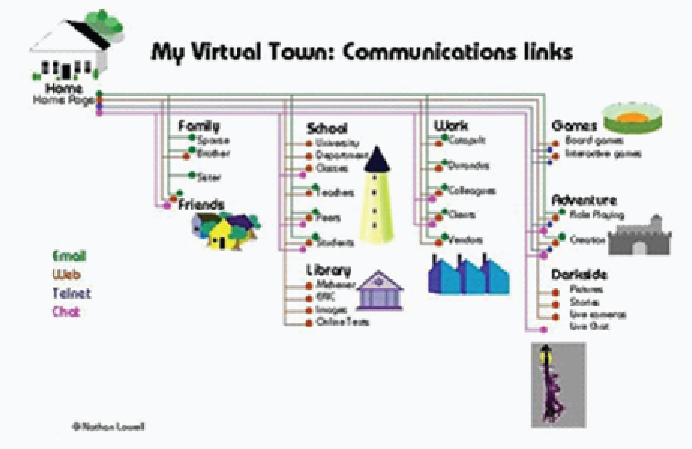Graphics Reference
In-Depth Information
Figure 6. Nathan Lowell, “My Virtual Town: Communication Links” (©2004, N. Lowell. Used with
permission)
With several formats and programming lan-
guages, the semantic web is an enhancement of the
World Wide Web that allows finding and analyzing
data on the web. In 2007 Feigenbaum, Herman,
Hongsermeier, Neumann, & Stephens described
the semantic web in Scientific American follow-
ing an earlier article on this theme written for the
Scientific American by Berners-Lee, Hendler and
Lassila (2001). According to the authors, “the data
format, ontologies, and reasoning software would
operate like one big application on the World
Wide Web, analyzing all the raw data stored in
online databases as well as all the data about the
text, images, video and communications the Web
contained.” Ontologies have been meant here as
sets of statements translating information from
different databases into common terms and rules
that allow software agents to reason about the
information described in those terms.
A website must comply with many features
that are required or necessary: it must open fast,
should be visually appealing, contain all informa-
tion needed, and must be easy to find on the web.
A great part of visited pages are revisited pages,
but it is not so easy to find them again, unless a
good navigation system is developed. Developing
visual ways of navigation on the web became one
of the fastest growing information visualization
techniques. To make web page hunting easy,
pages should be clustered according to the themes,
previous visits, interactions with other previously
visited pages, then visually organized, many times,
with visually catchy metaphors. The web develop-
ers and analysts are designing web architecture
using many kinds of search machines, managing
a large database of documents, and creating web
interfaces keeping up with the concept of the
semantic web. Some concepts might be useful
when surfing the web, such as visualizing and
manipulating data in multiple dimensions, Java,
interaction techniques, 2D and 3D interaction
metaphors, and data mining.
As Lima (2011) states, a tree metaphor serves
to convey a variety of topics such as theological
events or an encyclopedia's table of contents, and
a tree metaphor has been widely used as a clas-

